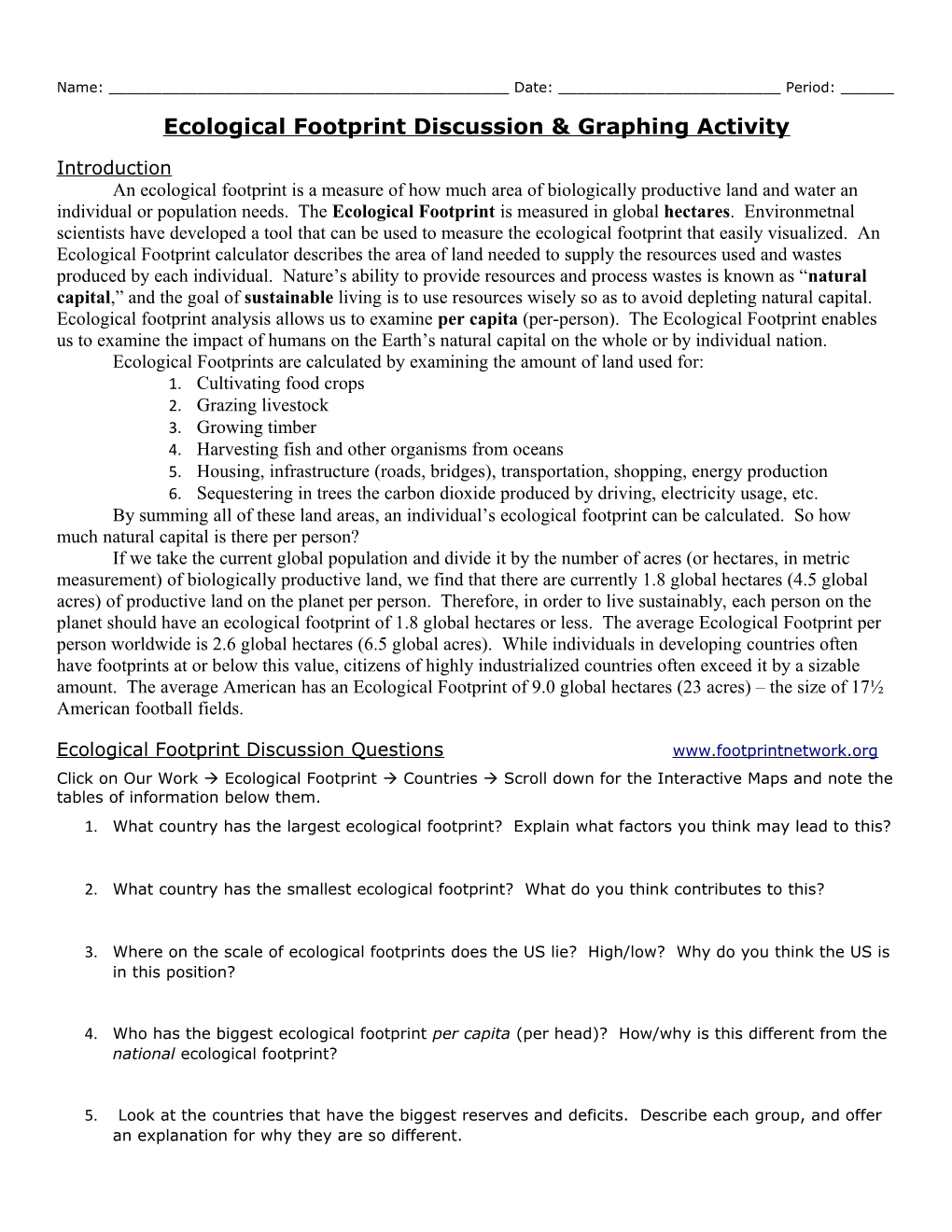Name: ______Date: ______Period: ______
Ecological Footprint Discussion & Graphing Activity
Introduction
An ecological footprint is a measure of how much area of biologically productive land and water an individual or population needs. The Ecological Footprint is measured in global hectares. Environmetnal scientists have developed a tool that can be used to measure the ecological footprint that easily visualized. An Ecological Footprint calculator describes the area of land needed to supply the resources used and wastes produced by each individual. Nature’s ability to provide resources and process wastes is known as “natural capital,” and the goal of sustainable living is to use resources wisely so as to avoid depleting natural capital. Ecological footprint analysis allows us to examine per capita (per-person). The Ecological Footprint enables us to examine the impact of humans on the Earth’s natural capital on the whole or by individual nation.
Ecological Footprints are calculated by examining the amount of land used for:
- Cultivating food crops
- Grazing livestock
- Growing timber
- Harvesting fish and other organisms from oceans
- Housing, infrastructure (roads, bridges), transportation, shopping, energy production
- Sequestering in trees the carbon dioxide produced by driving, electricity usage, etc.
By summing all of these land areas, an individual’s ecological footprint can be calculated. So how much natural capital is there per person?
If we take the current global population and divide it by the number of acres (or hectares, in metric measurement) of biologically productive land, we find that there are currently 1.8 global hectares (4.5 global acres) of productive land on the planet per person. Therefore, in order to live sustainably, each person on the planet should have an ecological footprint of 1.8 global hectares or less. The average Ecological Footprint per person worldwide is 2.6 global hectares (6.5 global acres). While individuals in developing countries often have footprints at or below this value, citizens of highly industrialized countries often exceed it by a sizable amount. The average American has an Ecological Footprint of 9.0 global hectares (23 acres) – the size of 17½ American football fields.
Ecological Footprint Discussion Questions
Click on Our Work Ecological Footprint Countries Scroll down for the Interactive Maps and note the tables of information below them.
- What country has the largest ecological footprint? Explain what factors you think may lead to this?
- What country has the smallest ecological footprint? What do you think contributes to this?
- Where on the scale of ecological footprints does the US lie? High/low? Why do you think the US is in this position?
- Who has the biggest ecological footprint per capita (per head)? How/why is this different from the national ecological footprint?
- Look at the countries that have the biggest reserves and deficits. Describe each group, and offer an explanation for why they are so different.
- What is the unit for Ecological Footprint and Biocapacity that we will use for our graph?(Hint: Based off the graphs you just reviewed)
Data Table #1:
Country / 1967 / 1976 / 1985 / 1994 / 2003 / 2012United States
Ecological Footprint (_____) / 9.51 / 10.63 / 10.05 / 10.3 / 10.21 / 8.4
Biocapacity (_____) / 4.86 / 4.57 / 4.59 / 4.33 / 3.99 / 3.72
Cameroon
Ecological Footprint (_____) / 1.27 / 1.25 / 1.16 / 0.98 / 0.95 / 1.13
Biocapacity (_____) / 5.11 / 4.14 / 3.16 / 2.44 / 1.92 / 1.67
China
Ecological Footprint (_____) / 0.91 / 1.18 / 1.35 / 1.67 / 2.15 / 3.51
Biocapacity (_____) / 0.94 / 0.83 / 0.83 / 0.82 / 0.84 / 0.93
Costa Rica
Ecological Footprint (_____) / 2.21 / 2.55 / 2.2 / 2.64 / 2.32 / 2.53
Biocapacity (_____) / 4.7 / 3.57 / 2.69 / 2.09 / 1.67 / 1.55
- Create a Double Line Graph that contains the Ecological Footprint and Biocapacity for the 4 countries listed above. Make sure your graph “TALKS” – include a title, axis & labels (with units), a key and scale (even increments). Graph must be hand drawn.
- In your own words, what is meant by sustainability? Is the US achieving it? Why/why not?
